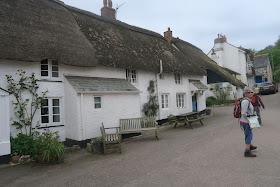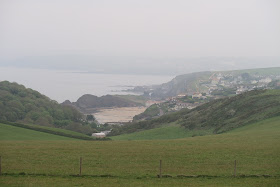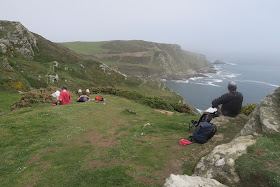The South West Odyssey was a long distance walk.
Five like-minded people started in 2008 from the Cardingmill Valley in Shropshire and by walking three days a year finished at Start Bay on the South Devon Coast in May 2019.
 |
| Devon |
As the map shows we did not plan to walk back round the ria; some amongst us can walk on water and they had promised a piggyback to the others. Sceptics might imagine I made that up and we would take a ferry – oh ye of little faith!
Car shuffling done, it was nearly ten (though only 200 words in) before we hauled on our boots beside Brian’s car in the carpark between Inner and Outer Hope…
 |
| Boots on in Inner Hope - with Hope Cove and Bolt Tail in the background |
 |
| Inner Hope |
…and up the hillside beyond having decided not to trek all the way out to Bolt Tail just to come back again.
 |
| Looking back down to Inner Hope |
Having cut the corner, we joined the South West Coastal Path east of Bolt Tail and walked along the cliff tops across a wide grassy sward.
It was easy going for the next 3km…
….though the path was not always surfaced.
Progress was slowed by frequent pauses to observe the birds perching on the multitude of flowering gorse bushes. Francis and Brian identified cirl buntings, stonechats, meadow pipits, linnets, skylarks, whitethroats and wheatear. Not being a birder, I paid no part in the identification, but did have a good look at one of the many stonechats and a cirl bunting through borrowed binoculars, and handsome little birds they are. Apparently, we were privileged to see cirl buntings as this stretch of Devon coast is their only toe-hold in the UK.
This gentle stroll came to a halt at Soar Mill Cove where a small and nameless stream (perhaps the Soar?) has forced its way through the seaside cliffs necessitating a zig-zag 100m descent and a gentler climb up.
 |
| Soar Mill Cove |
The climb may have been gentler and in two stages, but it was longer taking us above 135m.
 |
| Looking towards Soar Mill Cove after the second stage of the ascent |
Thereafter it was another pleasant amble through the gorse.
We decided to cut off Bolt Head as we had Bolt Tail (somebody had brought some bolt cutters) so took an early turning towards Salcombe, dropped down to cross the stream at Starehole Bottom (who thought that was a good name?) and regained the South West Coast Path in time for the climb towards Sharp Tor.
 |
| Up from Starehole Bottom |
We approached Sharp Tor on a stony path set into the cliff. Strangely evocative of a ‘Game of Thrones’ location it filled my mind with thoughts of ‘The Drowned God’ and ‘What is dead shall never die.’ Meanwhile Francis was looking over the cliff spotting ‘kittiwakes, lesser black-backed gulls, gannets, cormorants and a single fulmar’.
 |
| Up to Sharp Tor |
I was glad the rocky path round the tor had a railing, it was an exposed and scary place though the wheeling seabirds and tumbling Greyjoys (sorry that’s my GoT fantasy again) below us looked happy enough.
The path beyond was flat and easy, though still cut into the cliff…
 |
| Rock Formstions north of Sharp Tor |
 |
| Bluebells and wld garlic north of Sharp Tor (Photo: Brian) |
 |
| Salcombe centre is not yet in view |
 |
| South Sands - not quite Salcombe |
Although past the Castle we were
still a long kilometre short of the town centre and there was yet another
headland to cross on a narrow, walled road. I was 50m behind Francis and Alison
and even further behind Brian and Mike so I had no time to remove my jacket. I
was struggling, uncomfortably hot and beginning to doubt Salcombe’s existence
long before I reached the top.
But apparently Salcombe does
exist and walking down the main street with my jacket now in my rucksack I observed
Francis and Alison had stopped while Mike and Brian were a hundred metres down
the road and still going. Reaching Francis and Alison I saw they were standing
by a flight of steps with an arrow pointing down to the Portlesham ferry and
the Ferry Inn, just where we wanted to go.
Mike and Brian had disappeared
round the corner so we had to follow them down and found them at the main ferry
jetty looking mildly surprised at the wrong ferry. Being local, Brian had done a
recce a couple of weeks earlier and this was where our ferry had docked then,
but ‘then’ is not ‘now’ and they had walked straight past the relevant sign.
We all walked back up the hill, down
the steps and onto the deck of the Ferry Inn – a pint of lunch was the first priority.
 |
| Sitting in the sunshine outside the Ferry Inn, Salcombe. Why does everyone looks so happy? Mike has an enormous pot of tea all to himself. |
The Kingsbridge Estuary is less
than 300m wide between Salcombe and the Portlemouth landing stage…
…and we shared our short journey
with a small party of Buddhist monks from Thailand.
We walked down the other side of
the estuary to Mill Bay where the minor road ends. In the season Mill Bay may
well be crowded, the lane heading inland is lined with a hundred(ish) parking spaces,
all marked and numbered, but on this lovely May day it was deserted. The
boat we had watched making ready from the Ferry Inn came past under sail (and
engine, I think) and on the far shore, just behind its stern is a crenellated
wall and small tower. So that is Salcombe Castle.
 |
| Mill Bay |
We climbed gently away from the
coast to the regulation 100m up a path lined with large old trees. Mike and I
could not work out if they were dead or just late coming into leaf, but without
leaves we could not identify them.
At the top field paths and a
minor road took us back to the Coastal Path at Gara Rock which turned out to be
not a rock at all but a new up-market hotel with ‘Scandi-chic décor,
artisanal gin and superfood facials’ according to the Daily Telegraph. I
presume the writer knew what they meant.
Perhaps there is a rock as well,
but we did not linger, there were 3km between us and Prawle Point and Francis
set off at storming pace.
This was the best but most demanding part of this year’s walk. After a fairly gentle start across the grassy cliff top…
This was the best but most demanding part of this year’s walk. After a fairly gentle start across the grassy cliff top…
 |
| A gentle start after the descent from Gara Rock |
….the path clung to the cliff
side, continually either climbing or dropping but very rarely level. Sometimes the
surface was easy to walk on
…at other times it was stony
with rocky sections, some quite exposed, which needed to be carefully negotiated.
I took few photos on this section, partly because I needed to concentrate on not
falling in the water, and partly because my camera was playing up, the lens
refusing to either fully extend or retract.
I would not like to walk this
wild and rugged coastline in poor weather, but we were blessed with gentle
sunshine as we crossed Pig’s Nose, passed the Ham Stone and continued to Gammon
Head – a theme perhaps? In the morning gates and signposts had been helpfully
marked with grid references, here there were none and as one rocky cove looks
much like another, I was never sure where we were. Alison says the picture
below is of Gammon Head.
Struggling to keep up with the
relentless pace I called a brief respite, probably on Gammon Head, but it could
have been some other part of the porker. Most seemed happy enough to take a
breather.
Meanwhile Alison noticed the
unusual combination of gorse and bluebells growing together.
 |
| Bluebells and gorse, Gammon Head (Photo: Alison) |
Continuing, Brian
and I raised cameras at the sight of a trio of sheep artistically arranged on a
rocky outcrop. Two of the sheep absented themselves before shutters could be
pressed, but even one looks good. For once my camera behaved itself, but Brian
had the better photo.
 |
| Sheep in charge, Gammon Head (photo: Brian) |
Minutes later Alison
spotted a slowworm absorbing the sun on our path. I always thought they were
small snakes, but apparently they are legless lizards (should have stayed off
the gin).
 |
| Slowworm on the approach to Prawle Point |
We reached the
final climb onto Prawle Point, the southernmost point of Devon. For the first
seven or eight years of this walk there was no defined endpoint, but at some
stage Francis decided Prawle Point would be it, so as we came up the grassy
slope to the Lookout Station atop the headland the Odyssey was about to finish.
 |
| Up the grassy slope to the Lookout Station on Prawle Point |
Only it wasn’t.
These walks are three-day events (though with more cross-country and less dressage)
and this was only the end of Day 2; there would be more tomorrow when our 12-year
marathon would ironically end in Start Bay. Prawle Point is more photogenic
from the east, so here is a photo from tomorrow showing its stone arch and Lookout
Station
Once on the
headland it was a short walk to Mike’s car in the National Trust Car Park at
the end of the minor road out to the point.
Francis had been
looking forward to a pint in the Pig’s Nose in East Prawle to mark our southernmost
location, but time was against us. Brian’s car still had to be fetched from
Inner Hope, and we were booked for a celebratory dinner at The Cricketer in Beesands
at 7.
After a tough
19km I was sore and tired but revived after my shower - once all the driving
was completed. The Cricketer did us proud and a convivial evening was had by
all.
Footnote: I am
sorry to announce the (perhaps temporary) demise of my Cannon Powershot. I have
not had it very long, but in that time this complex and delicate piece of machinery
has nestled in my sweaty palm in the heat of southern India, been soaked in a
Dartmoor hailstorm and climbed a dune in the Empty Quarter. In short, I have mistreated
it.
The South West Odyssey (English Branch)
Day 1 to 3 (2008);Cardingmill Valley to Great Whitley
Day 4 to 6 (2009) Great Whitely to Upton-on-Severn via the Malvern Ridge
Day 11 (2011) Perrott's Brook to the Round Elm Crossroads
Day 12 (2011) Walking Round Stroud
Day 13 (2012) Stroud to North Nibley
Day 14 (2012) North Nibley to Old Sodbury
Day 15 (2012) Old Sodbury to Swineford
Day 16 (2013) Along the Chew Valley
Day 17 (2013) Over the Mendips to Wells
Day 18 (2013) Wells to Glastonbury 'The Mountain Route'
Day 19 (2014) Glastonbury to Langport
Day 20 (2014) Along the Parrett and over the Tone
Day 21 (2014) Into the Quantocks
Day 22 (2015) From the Quantocks to the Sea
Day 23 (2015) Watchet, Dunster and Dunkery Hill
Day 24 (2015) Dunkery Beacon to Withypool
Day 25 (2016) Entering Devon and Leaving Exmoor
Day 26 (2016) Knowstone to Black Dog on the Two Moors Way
Day 27 (2016) Morchard Bishop to Copplestone
Day 28 (2017) Down St Mary to Drewsteignton
Day 29 (2017) Drewsteignton to Bennett's Cross
Day 30 (2017) Bennett's Cross to Lustleigh
Day 31 (2018) Southwest Across the Moor from Lustleigh
Day 32 (2018): South to Ugborough
Day 33 (2018): Ugborough to Ringmore
Day 34 (2019): Around the Avon Estuary to Hope Cove
Day 35 (2019): Hope Cove to Prawle Point
Day 36 (2019): Prawle Point to Start Bay: The End
+
The Last Post
That's All Folks - The Odyssey is over
Day 25 (2016) Entering Devon and Leaving Exmoor
Day 26 (2016) Knowstone to Black Dog on the Two Moors Way
Day 27 (2016) Morchard Bishop to Copplestone
Day 28 (2017) Down St Mary to Drewsteignton
Day 29 (2017) Drewsteignton to Bennett's Cross
Day 30 (2017) Bennett's Cross to Lustleigh
Day 31 (2018) Southwest Across the Moor from Lustleigh
Day 32 (2018): South to Ugborough
Day 33 (2018): Ugborough to Ringmore
Day 34 (2019): Around the Avon Estuary to Hope Cove
Day 35 (2019): Hope Cove to Prawle Point
Day 36 (2019): Prawle Point to Start Bay: The End
+
The Last Post
That's All Folks - The Odyssey is over















The monks and their partners who got on the little ferry with us said they were from Bristol! When questioned a little further they eventually said 'originally from Thailand'. Yes, the pictures definitely show Gammon Head.
ReplyDeleteI'm sorry about your trusty camera - not trusty any more though.
The ferry was the only public transport we used on the whole Odyssey ie.within a days walk. Even then we only used cars to get to each day's starts and finishes.
ReplyDeleteWe were very fortunate with the weather and the time of year we had chosen to do this section but, I have to say, that it was one of the best day’s walking I can remember. Whilst a little misty, the views were still superb and the flora and fauna were special. As Alison’s graph showed it was not an easy day’s walk but, with the exception of the tedious walk into Salcombe, it was very rewarding. The Cirl Bunting has spread to the North Devon coast but it is still a relatively small area where it can be found and it was in abundance on our day. I will learn my lesson about doing reconnaissance trips!
ReplyDelete